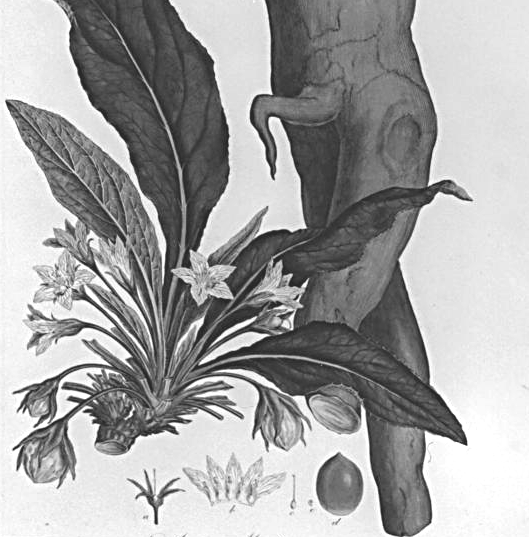The mandrake (Mandragora officinalis) is one of 2500 species of plants belonging to the Solanaceae family, which also contains tomatoes, potatoes, chillies, aubergines, peppers, tobacco, deadly nightshade and henbane.[a]Although the tubers of the potato, for instance, are a staple of the Western diet, the fruits of the plant contain high levels of the poisonous solanine.[1] Commonly known as the nightshades, all of them contain powerful alkaloids.[1][b]Alkaloids are naturally occurring compounds that have been known since ancient times for their therapeutic and recreational effects. Common examples are morphine, nicotine, and cocaine. The particular alkaloid contained in mandrake is hyoscine, which can cause hallucinations, delirium and, in larger doses, coma and death.[2]
The psychoactive effects of mandrake were well known to Greek and Roman physicians; writing in about 400 BCE Hippocrates warned those preparing drafts of mandrake to mix the berry juices “in a smaller dose than will induce mania”.[3]
The shape of the mandrake’s long and frequently bifid root can resemble the body of a human, which together with the plant’s psychoactive properties led to its association with magic, witchcraft, and the supernatural.[2] The unknown author of the second-century Physiologus suggests that the Tree of Knowledge is Mandragora, eating the fruit of which caused Adam and Eve to be expelled from the Garden of Eden.[4]
Association with fertility
The mandrake’s earliest association with fertility appears in the Book of Genesis, in which the childless Rachael asks her sister Leah if she can borrow the mandrakes that her son has just collected. In a similar vein, the medieval doctrine of signaturesObservation that the form of a medicinal plant in some way resembles the organ or disease it can be used to treat. suggested that the shape of the plant revealed that as well as being a general panacea it had a role to play in the fertility of females; those seeking to conceive were advised to sleep with a mandrake root under their pillows.[2]
Perhaps counter-intuitively, the mandrake was also used in spells to quell the sexual ardour of either sex. In her Liber subtilitates diversarum natuaram creaturarum (Book on the Subtleties of Many Kinds of Creatures), written in about 1160, Hildegard describes how a mandrake root should be washed and then attached to the abdomen for three days and nights. It should then be removed, split in two, and the pieces attached to the thighs for a further three days. The right arm of the root was then to be pulverised, and the resulting powder swallowed. Naturally a man should use a female mandrake root and a woman a male one.[5]
Medicinal use
In its native home around the Mediterranean and the Middle East mandrake has been used as a painkiller for thousands of years. Its earliest use as a surgical anaesthetic was described by the Greek physician Dioscorides, writing in about 60 AD, and its use as a tincture known as mandragora, or in combination with other herbs such as opium, hemlock and henbane, is described in pre-Roman documents.[2]
Collection rituals
“The cry of the mandrake is fatal to anyone who hears it,” declares Hermione in J. K. Rowling’s Harry Potter and the Chamber of Secrets. Certainly in medieval times there was a widespread belief that when the root was pulled from the ground it produced a shriek that drove people mad and led to their deaths.[1]
In the earliest myths it was claimed that a demon inhabited the root of the mandrake, and would kill anyone who attempted to uproot it. Later elaboration led to the idea of the plant emitting a lethal shriek or groan, which could be blocked out by blowing on a horn, or sealing one’s ears with wax.[2]
The earliest account of how to gather mandrake comes from the Greek writer Theophrastus (c. 371–287 BC) in his Historia plantarum:
The 13th-century Spanish Muslim herbalist Ibn al-Baitar offered an alternative method, but one that cost a life. Anyone wishing to harvest mandrake should plug their ears, tie the plant to a dog and place some meat out of the dog’s reach; when the animal runs to the meat it will pull the screaming root out of the soil, whereupon the dog will die. al-Baitar claimed to have tried this technique himself, with no harm to the dog.[1]
Mandrake roots were highly sought after, so it seems very likely that the various collection myths were invented to discourage their theft.[2]
Notes
| a | Although the tubers of the potato, for instance, are a staple of the Western diet, the fruits of the plant contain high levels of the poisonous solanine.[1] |
|---|---|
| b | Alkaloids are naturally occurring compounds that have been known since ancient times for their therapeutic and recreational effects. Common examples are morphine, nicotine, and cocaine. |


